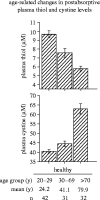Oxidative stress and ageing: is ageing a cysteine deficiency syndrome?
- PMID: 16321806
- PMCID: PMC1569588
- DOI: 10.1098/rstb.2005.1770
Oxidative stress and ageing: is ageing a cysteine deficiency syndrome?
Abstract
Reactive oxygen species (ROS) are constantly produced in biological tissues and play a role in various signalling pathways. Abnormally high ROS concentrations cause oxidative stress associated with tissue damage and dysregulation of physiological signals. There is growing evidence that oxidative stress increases with age. It has also been shown that the life span of worms, flies and mice can be significantly increased by mutations which impede the insulin receptor signalling cascade. Molecular studies revealed that the insulin-independent basal activity of the insulin receptor is increased by ROS and downregulated by certain antioxidants. Complementary clinical studies confirmed that supplementation of the glutathione precursor cysteine decreases insulin responsiveness in the fasted state. In several clinical trials, cysteine supplementation improved skeletal muscle functions, decreased the body fat/lean body mass ratio, decreased plasma levels of the inflammatory cytokine tumour necrosis factor alpha (TNF-alpha), improved immune functions, and increased plasma albumin levels. As all these parameters degenerate with age, these findings suggest: (i) that loss of youth, health and quality of life may be partly explained by a deficit in cysteine and (ii) that the dietary consumption of cysteine is generally suboptimal and everybody is likely to have a cysteine deficiency sooner or later.
Figures















Similar articles
-
Oxidative aging and insulin receptor signaling.J Gerontol A Biol Sci Med Sci. 2005 Nov;60(11):1378-85. doi: 10.1093/gerona/60.11.1378. J Gerontol A Biol Sci Med Sci. 2005. PMID: 16339322 Review.
-
Differential reconstitution of mitochondrial respiratory chain activity and plasma redox state by cysteine and ornithine in a model of cancer cachexia.Cancer Res. 1999 Jul 15;59(14):3527-34. Cancer Res. 1999. PMID: 10416620
-
Deficient synthesis of glutathione underlies oxidative stress in aging and can be corrected by dietary cysteine and glycine supplementation.Am J Clin Nutr. 2011 Sep;94(3):847-53. doi: 10.3945/ajcn.110.003483. Epub 2011 Jul 27. Am J Clin Nutr. 2011. PMID: 21795440 Free PMC article. Clinical Trial.
-
Aberrant insulin receptor signaling and amino acid homeostasis as a major cause of oxidative stress in aging.Antioxid Redox Signal. 2008 Apr;10(4):661-78. doi: 10.1089/ars.2007.1953. Antioxid Redox Signal. 2008. PMID: 18162053 Review.
-
Tumor necrosis factor-alpha inhibits myogenesis through redox-dependent and -independent pathways.Am J Physiol Cell Physiol. 2002 Sep;283(3):C714-21. doi: 10.1152/ajpcell.00418.2001. Am J Physiol Cell Physiol. 2002. PMID: 12176728
Cited by
-
Vitamin D upregulates glutamate cysteine ligase and glutathione reductase, and GSH formation, and decreases ROS and MCP-1 and IL-8 secretion in high-glucose exposed U937 monocytes.Biochem Biophys Res Commun. 2013 Jul 19;437(1):7-11. doi: 10.1016/j.bbrc.2013.06.004. Epub 2013 Jun 11. Biochem Biophys Res Commun. 2013. PMID: 23770363 Free PMC article.
-
Predicting Reactive Cysteines with Implicit-Solvent-Based Continuous Constant pH Molecular Dynamics in Amber.J Chem Theory Comput. 2020 Jun 9;16(6):3689-3698. doi: 10.1021/acs.jctc.0c00258. Epub 2020 May 6. J Chem Theory Comput. 2020. PMID: 32330035 Free PMC article.
-
Golgi stress response reprograms cysteine metabolism to confer cytoprotection in Huntington's disease.Proc Natl Acad Sci U S A. 2018 Jan 23;115(4):780-785. doi: 10.1073/pnas.1717877115. Epub 2018 Jan 9. Proc Natl Acad Sci U S A. 2018. PMID: 29317536 Free PMC article.
-
Macroscopic and histological variations in the cellular tapetum in dogs.J Vet Med Sci. 2014 Aug;76(8):1099-103. doi: 10.1292/jvms.14-0132. Epub 2014 Apr 30. J Vet Med Sci. 2014. PMID: 24784162 Free PMC article.
-
Identification of a redox-sensitive switch within the JAK2 catalytic domain.Free Radic Biol Med. 2012 Mar 15;52(6):1101-10. doi: 10.1016/j.freeradbiomed.2011.12.025. Epub 2012 Jan 15. Free Radic Biol Med. 2012. PMID: 22281400 Free PMC article.
References
-
- Acharyya S, Ladner K.J, Nelsen L.L, Damrauer J, Reiser P.J, Swoap S, Guttridge D.C. Cancer cachexia is regulated by selective targeting of skeletal muscle gene products. J. Clin. Invest. 2004;114:370–378. 10.1172/JCI200420174 - DOI - PMC - PubMed
-
- Arivazhagan P, Ramanathan K, Panneerselvam C. Effect of dl-alpha-lipoic acid on mitochondrial enzymes in aged rats. Chem. Biol. Interact. 2001;138:189–198. 10.1016/S0009-2797(01)00268-X - DOI - PubMed
-
- Azzoni L, Papasavvas E, Chehimi J, Kostman J.R, Mounzer K, Ondercin J, Perussia B, Montaner L.J. Sustained impairment of IFN-γ secretion in suppressed HIV-infected patients despite mature NK cell recovery: evidence for a defective reconstitution of innate immunity. J. Immunol. 2002;168:5764–5770. - PubMed
-
- Balkan J, Kanbagli O, Mehmetcik G, Mutlu-Turkoglu U, Aykac-Toker G, Uysal M. Increased lipid peroxidation in serum and low-density lipoproteins associated with aging in humans. Int. J. Vitam. Nutr. Res. 2002;72:315–320. - PubMed
-
- Barford D, Jia Z, Tonks N.K. Protein tyrosine phosphatases take off. Nat. Struct. Biol. 1995;2:1043–1053. 10.1038/nsb1295-1043 - DOI - PubMed
Publication types
MeSH terms
Substances
LinkOut - more resources
Full Text Sources
Other Literature Sources
Medical
Research Materials

